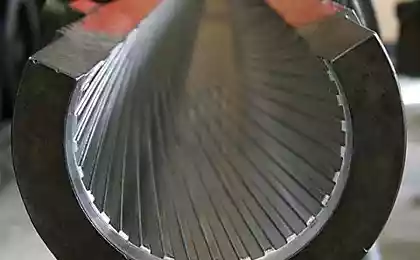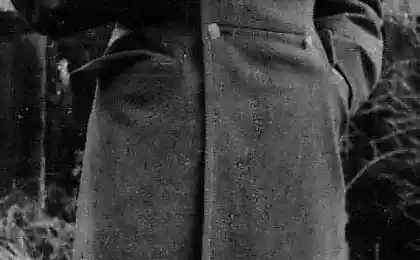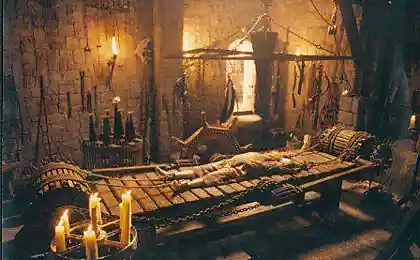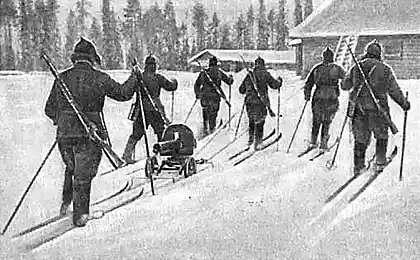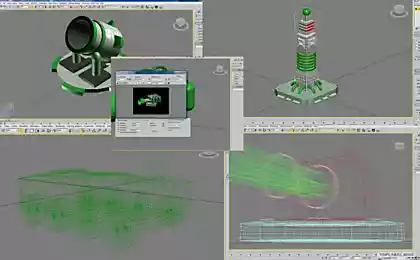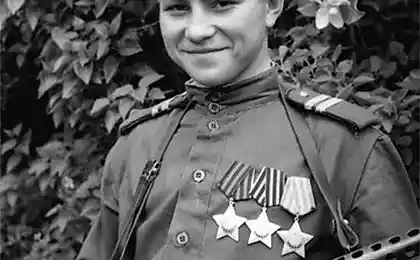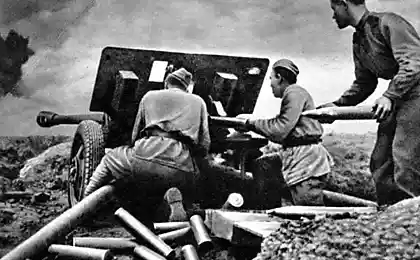3788
Instruments of torture (24 photos)
1. Chair questioning.
Armchair interrogation was used in Central Europe. In Nuremberg and Fegensburge until 1846 were regularly conducted the preliminary investigation of its use. Naked prisoner seated on a chair in such a position that at the slightest movement in his skin pierced studs. Typically, the torture lasted for several hours, and butchers often reinforced flour agonizing victim, piercing her limbs, using forceps or other instruments of torture. These chairs have a variety of shapes and sizes, but all of them were equipped with spikes and immobilization means sacrifice.
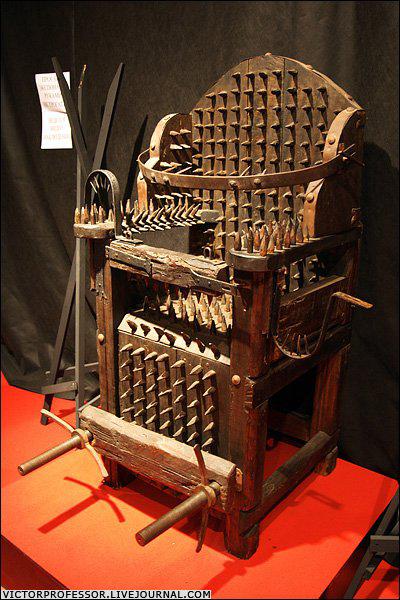
2. Hand Saw.
About her there is nothing to say except that it caused the death of even worse than death at the stake. The instrument is controlled by two people who sawed the convicted person, suspended upside down with his feet,
attached to two supports. The very position, causing blood flow to
brain, forced the victim to experience unprecedented torments for
long. This tool was used as a punishment for various
crime, but particularly like it was used against
homosexuals and witches. We believe that this facility is widely
French judges have used against witches, who conceived of the
"Devil's Nightmare" or even from Satan himself.

3. Throne.
This tool was created as a pillory in the form of a chair, and
sarcastically called the Throne. The victim was placed upside down and her legs
strengthened with wooden blocks. Such torture enjoyed
popular among the judges who want to follow the letter of the law. In fact,
legislation to regulate the use of torture, allows to use
Throne only once during interrogation. But the majority of judges around this
usually just calling the next session of the continuation of the same first.
Using the Throne is allowed to declare a session, even if it
It lasted 10 days. As the use of the Throne did not leave irremovable
marks on the victim's body, it is very suitable for long
use. It should be noted that along with this torture
prisoners "use" as water and a hot iron.
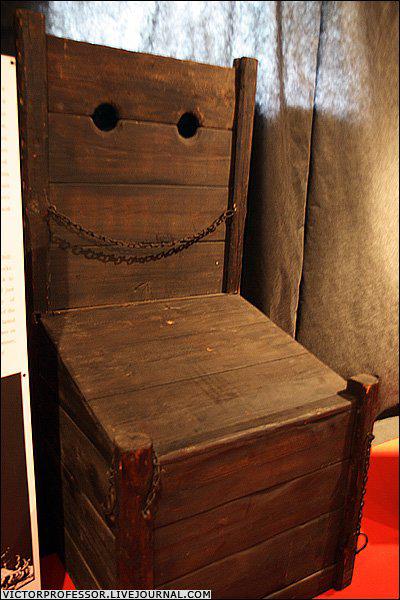
4. The daughter of a janitor or stork.
Use of the term "Stork" is credited with the Rome Court of the Holy Inquisition during the second half of the XVI century. to about 1650. The same name that was given to the instruments of torture, LA Muratori, in his book "Italian Chronicle" (1749). The origin is even more strange name "the janitor's daughter" is unknown, but it is given by analogy with the name of an identical device in the Tower of London. Whatever the origin of the name, this tool is an excellent example of the great variety of systems of coercion, which were used during the Inquisition. The position of the victim has been carefully thought out. Within minutes, a posture led to severe muscle spasms in the abdomen and anus. Next spasms began to spread in the chest, neck, arms and legs, becoming more painful, particularly at the initial appearance of a spasm. After some time, attached to the stork from simple experiences of torture to complete madness. Often, while the victim suffered in this terrible position, it is further tortured with a hot iron, and other means. Iron shackles etched into the flesh of the victim and cause gangrene, and sometimes death.
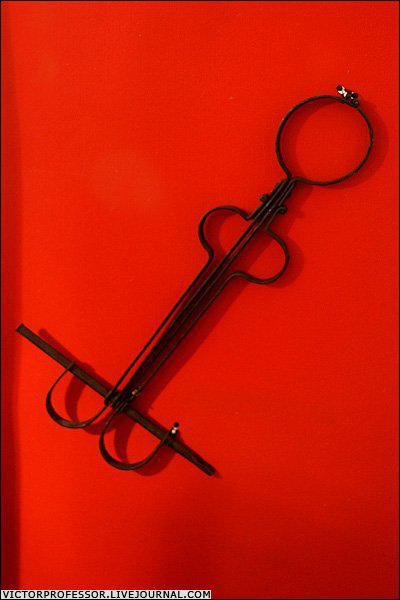
5. Chair witches.
Chair of the Inquisition, known as the Witch chair, highly regarded as a good remedy for silent women accused of witchcraft. This tool is especially common Austrian widely used by the Inquisition. The chairs were of different shapes and sizes, all equipped with
spiked with handcuffs, for fixing blocks of the victim and, more often, with
iron seats, which if necessary can be
to heat. We found evidence of the use of tools for
slow killing. In 1693 in the Austrian city of Gutenberg judge
Wolf von Lampertish led process on charges of witchcraft Mary
Vukinets 57 years. It was planted in a chair witch eleven days and
nights while torturers burned her legs with a hot iron
(Insletrlaster). Maria Vukinets died under torture in his right mind from the pain, but not
confessed to the crime.

6. Number of ordinary.
Technology use is clear and without comment.
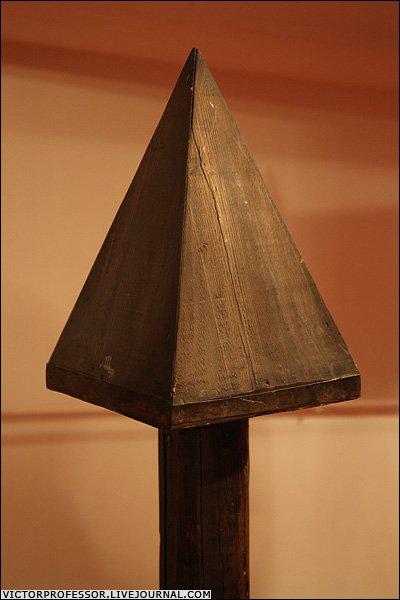
7. Dyba-hanger.
This is undoubtedly the most common cap, and it was often used in the first trial, as considered easy option torture the accused contacted hands behind his back and threw the other end of the rope through the ring winch victim was left in such a position, either strongly and continuously pulled the rope. Often the victims were tied to notes extra weight, and the body torn with tongs, such as, for example, "Spider witch" to make torture less soft. The judges thought that witches know many ways of witchcraft, which allow them to quietly endure the torture, so do not always manage to achieve recognition We can refer to a series of processes in Munich in the early XVII century against eleven people. Six of them had been tortured continuously with the help of an iron boot, one of the women underwent breast dismemberment following five wheel, and one impaled. They, in turn, told another twenty one person who immediately questioned Tetenvange. Among the new charges was a very respectable family. His father died in prison, his mother, after it was tested on the rack eleven times, confessed everything, what she was accused. Daughter, Agnes, twenty-one years, stoically endured the test on the rack with extra weight, but did not recognize his guilt, and only said that she forgives his executioners and prosecutors. Only a few days of incessant trials in a torture chamber, she was told about the full recognition of her mother. After a suicide attempt, she admitted all heinous crimes, including cohabitation with the Devil to the age of eight, in devouring the hearts of thirty people, the participation in the Sabbat, that caused ouryu and renounced God. Mother and daughter were sentenced to be burned at the stake.
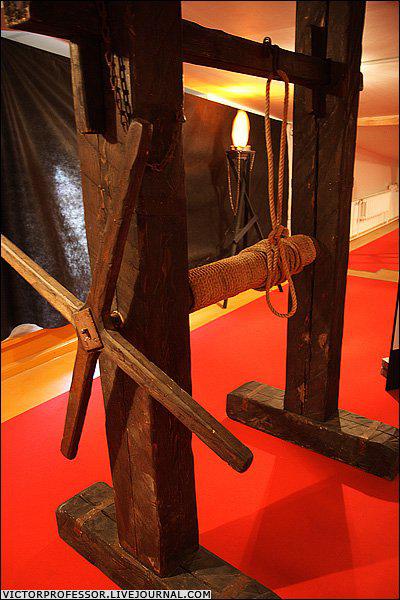
8. Vigil Security or cradle.
According to the inventor, Ippolito Marsili introduction Vigil was a turning point in the history of torture. The current system of obtaining recognition does not involve bodily injury. It is not broken vertebrae, ankle inverted or crushed joints; the only substance that is suffering - the nerves of the victim. The idea of torture was to keep the victim awake for as long as possible, it was a kind of torture of insomnia. "Vigil", which originally was not seen as a cruel torture takes various forms in the times of the Inquisition, such as in the figure. The victim was lifted to the top of the pyramid and then gradually lowered. The top of the pyramid was to penetrate the anus, testicles or falcon, and if a woman was tortured - the vagina. The pain was so strong that it is often accused fainted. If so, the procedure is delayed until the victim wakes up. In Germany, the "torture vigil" is called "the cradle of security».

9. Brazier.
In the past, there was no association, "Amnesty International", no one interfered in the affairs of justice and not to protect those who fell into his clutches. The executioners were free to choose any, in their view suitable means to extract confessions. Often they are used, and the brazier. The victim was tied to the bars and then "roasted" until not yet received a sincere repentance and confession that led to the discovery of new criminals. And life went on.
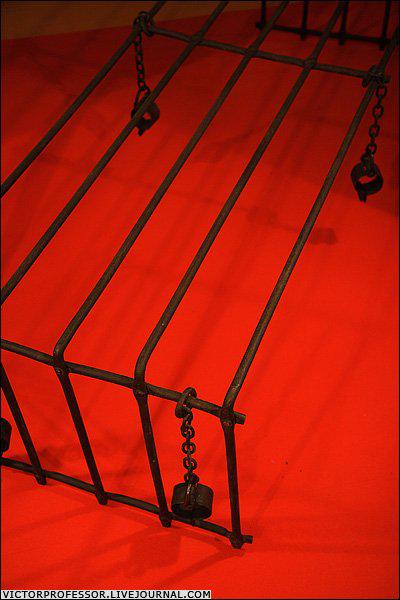
10. Torture water.
In order to best perform the procedure of this torture the accused are on one of the species reared, or in a special large table with a rising middle part. After the arms and legs of the victim were tied to the edges of the table, the executioner was about to work in one of several ways. One of these methods is that the sacrifice made by means of the funnel to swallow a large amount of water and then beaten on his stomach inflated and arched. Another form provided space in the throat of the victim rag tubes through which water is poured slowly, leading to bloating and strangulation victim. If that was not enough, the tube pulled, causing internal injuries, and then inserted again and the process repeated. Sometimes used torture with cold water. In this case, the defendant hours lying naked on a table under a stream of cold water. It is interesting to note that this kind of torture was considered as easy and confessions obtained in this way, the court accepted as voluntary and data defendants without torture.
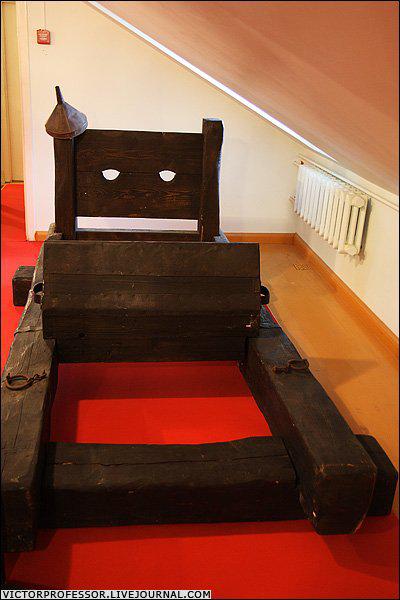
11. Nuremberg virgin.
The idea of mechanizing torture was born in Germany and can not help the fact that Nuremberg has the origin of a virgin. It got its name from the resemblance to the Bavarian girl and because her prototype was developed and first used in the dungeon of a secret court in Nuremberg. Charges placed in the sarcophagus where the body is unfortunate pierce sharp spikes, arranged so that no vital organs had not been hurt, and agony lasted for a long time. The first case of litigation with "Virgin" is dated 1515 year. He was described in detail by Gustav Freytag in his book «bilder aus der deutschen vergangenheit». Punishment befell guilty of forgery, which suffered a sarcophagus inside three days.
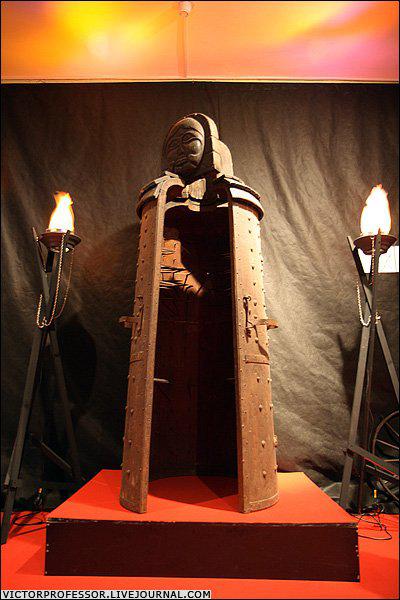
12. the Wheel.
Very popular system as torture and execution, used only when the charge of witchcraft. Typically, the procedure was divided into two phases, both quite painful. The first was in the majority of fractures of bones and joints with a small wheel, called wheel crushing and equipped with lots of spikes on the outside. The second ball is designed for the case of execution. It was assumed that the victim, beaten and mutilated in a way, just like a rope slip between the spokes of a wheel on a long pole, where it will be waiting for death. A popular variation of this penalty has combined the wheel and burned at the stake - in this case, death came quickly. The procedure was described in the materials of one of the trials in the Tyrol. In 1614, a tramp named Wolfgang Zelveyzer of Gastein, convicted of dealings with the devil and nasylanii storm, was sentenced Leyntsa simultaneously to the wheel and burned at the stake.
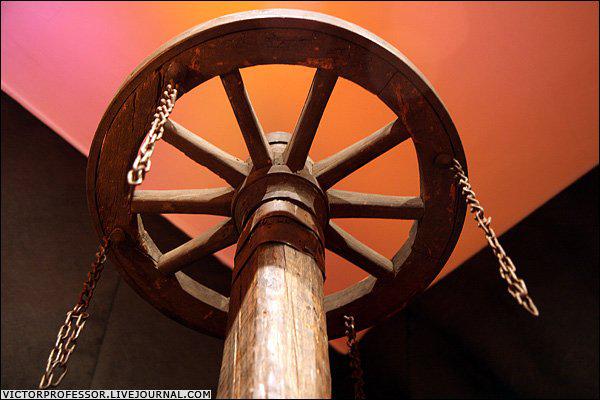
13. Press the limbs.

14. Press the skull.
This medieval device, it should be noted, is highly valued, particularly in northern Germany. Its function was quite simple: the victim's chin is placed on a wooden or iron support, and cover is screwed onto the head zhertvy.y & gt; First appeared overwhelmed by the teeth and jaw, and then, as the pressure grew, brain tissue starts to flow out of the skull. Over time, this instrument has lost its significance as the murder weapon, and has become widespread as a weapon of torture. In some Latin American countries are very similar device is used to this day. Despite the fact that the cover of the device and lower support lined with a soft material that leaves no trace on the victim, the device causes a prisoner in a state of "readiness to cooperate" after only a few turns of the screw.

15. impalement.
Impalement, one of the most evil and barbaric methods of punishment, has probably Assyrian-Babylonian origin. Spread in the Middle East, penalty applied during the wars of the Ottoman Empire against the infidels "against those convicted of illegal possession of weapons. The condemned were stripped naked, and then planted into thin sharpened stakes. Paraded at the walls of the fortress, executed sometimes painfully die within a few days. This was to intimidate the besieged. Especially widely used impalement Tepets Vlad (the famous Count Dracula), who executed thousands of Turks after the victory in the Battle of Wallachia.
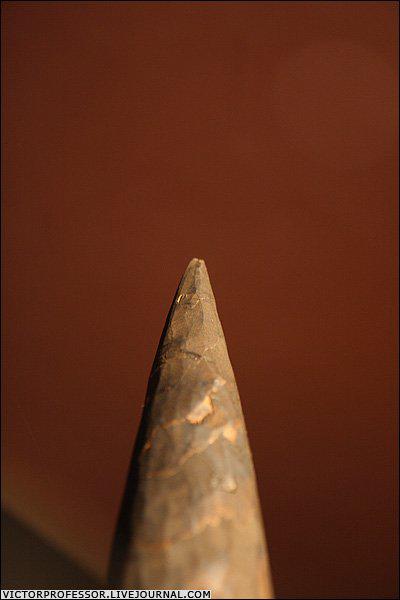
16. Pillory.
Pillory was a widespread method of punishment at all times and under any social system. The condemned was placed in the pillory for a certain time, from several hours to several days. Falls on the period of punishment bad weather aggravates the situation of the victim and increased flour that is likely to be regarded as "divine retribution". Shame, on the one hand, could be considered a relatively mild form of punishment in which the perpetrators have been exhibited in a public place for all to ridicule. On the other hand, chained to the pillory were completely exposed to "the court of the people": anyone could insult them by word or action, spit on them or throw a stone - tikoe treatment, which could be the cause of popular indignation or personal enmity, often led to injury or even the death of the convicted person.
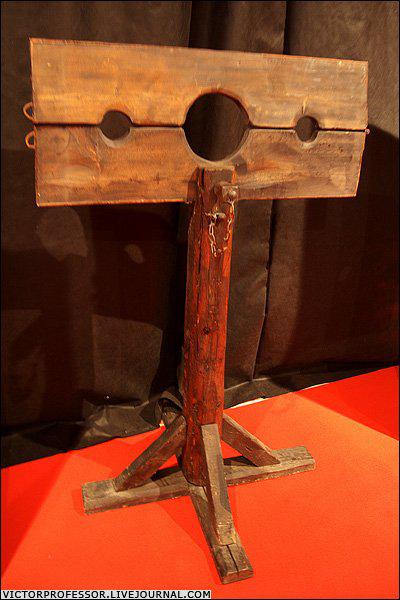
17. Violin gossips.
It could be a wood or iron, for one or two women. It was an instrument of soft torture having more psychological and symbolic meaning. There is no documentary evidence that the use of the device resulted in physical injury. It is applied mainly to the guilty of defamation or insulting the person of the victim guki and neck fixed in a small hole, so punished rendered in prayer. You can imagine the suffering of the victims of circulatory disorders and pain in the elbow when the device is worn on the long term, sometimes for several days.
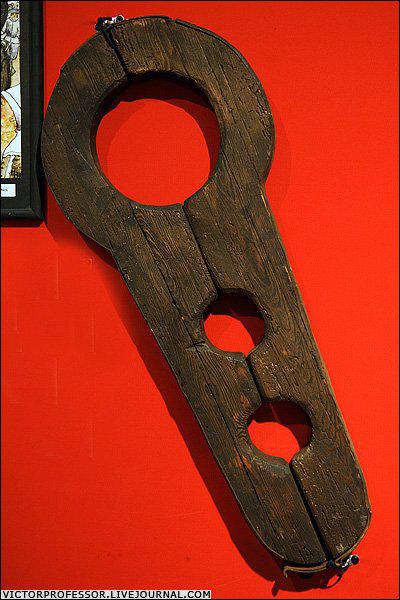
18. Prayer Cross.
A vicious tool used to commit the offender in a cross position. Credible allegations that the Cross was invented in Austria in the XVI -XVII centuries. This follows from the book "Justice in the old days" from the collection of the Museum of Justice in Rottenburg Tauber (Germany). A very similar model that was in the tower of the castle of Salzburg (Austria), mentioned in one of the most detailed descriptions.
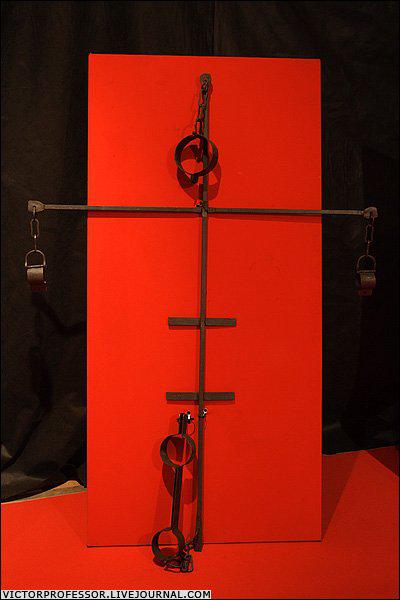
19. Dyba.
This is one of the most common instruments of torture occurring in historical descriptions. Rack used throughout Europe. Usually this instrument is a large table with legs or without them, who were forced to lie on the convict and his hands and feet were fixed using wooden planks. Immobility thus sacrifice "stretched", causing her excruciating pain, often for as long as the muscles are not torn. Rotating drum for pulling chains used not in all versions buck, but only in the most ingenious "upgraded" model. The executioner could cut up the victim's muscles to accelerate the final break tissue. The victim's body was stretched out more than 30 cm before the break. Sometimes the victim was tied tightly to the rack to make it easier to use other methods of torture, such as forceps for clamping nipples and other sensitive parts of the body, burning with hot irons, and others.

20. Dyba.
Element design.
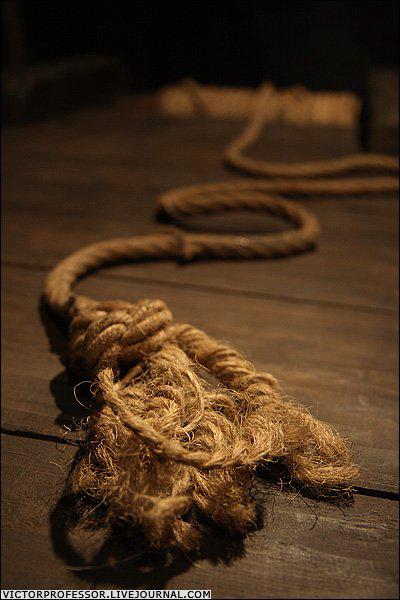
21. Garrote.
It is an instrument of punishment was used in Spain until recently. Last officially registered with Garrote penalty was made in 1975. Bombers were put on a chair with his hands tied behind his back, an iron collar rigidly fixed position of the head. During the execution of the executioner tightened the screw, and an iron wedge slowly entered the convict skull, leading to his death. Another version of the more common lately - suffocation by a metal wire. This method of execution is often shown in art films, especially films about espionage.

22. Cervical traps.
Weapons, which is used by police and prison overseers different specific functions - to control and repression of unarmed prisoners. Of certain interest is cervical trap - ring with nails on the inner side and with a device resembling a trap on the outside. Any prisoner who tried to hide in the crowd, it was easy to stop using this device. After being caught by the neck, he could not escape, and he was forced to follow a supervisor without fear that he will resist. These tools are still used in some countries, and in most cases they are equipped with electric shock devices.

23. Iron gag.
The tool was used to stop the screams of the victims, to bother the inquisitors and interfere with their conversation with each other iron tube inside the ring firmly puts the victim in the throat, and a collar locked on the bolt head. Holes allow air to pass, but if you want it to be shut finger and cause choking. This device is often applied to those sentenced to be burned at the stake, especially on a large public ceremony called Autodafe when heretics were burned dozens. Iron Gag avoids a situation where the convicts choke sacred music their screams.
Armchair interrogation was used in Central Europe. In Nuremberg and Fegensburge until 1846 were regularly conducted the preliminary investigation of its use. Naked prisoner seated on a chair in such a position that at the slightest movement in his skin pierced studs. Typically, the torture lasted for several hours, and butchers often reinforced flour agonizing victim, piercing her limbs, using forceps or other instruments of torture. These chairs have a variety of shapes and sizes, but all of them were equipped with spikes and immobilization means sacrifice.

2. Hand Saw.
About her there is nothing to say except that it caused the death of even worse than death at the stake. The instrument is controlled by two people who sawed the convicted person, suspended upside down with his feet,
attached to two supports. The very position, causing blood flow to
brain, forced the victim to experience unprecedented torments for
long. This tool was used as a punishment for various
crime, but particularly like it was used against
homosexuals and witches. We believe that this facility is widely
French judges have used against witches, who conceived of the
"Devil's Nightmare" or even from Satan himself.

3. Throne.
This tool was created as a pillory in the form of a chair, and
sarcastically called the Throne. The victim was placed upside down and her legs
strengthened with wooden blocks. Such torture enjoyed
popular among the judges who want to follow the letter of the law. In fact,
legislation to regulate the use of torture, allows to use
Throne only once during interrogation. But the majority of judges around this
usually just calling the next session of the continuation of the same first.
Using the Throne is allowed to declare a session, even if it
It lasted 10 days. As the use of the Throne did not leave irremovable
marks on the victim's body, it is very suitable for long
use. It should be noted that along with this torture
prisoners "use" as water and a hot iron.

4. The daughter of a janitor or stork.
Use of the term "Stork" is credited with the Rome Court of the Holy Inquisition during the second half of the XVI century. to about 1650. The same name that was given to the instruments of torture, LA Muratori, in his book "Italian Chronicle" (1749). The origin is even more strange name "the janitor's daughter" is unknown, but it is given by analogy with the name of an identical device in the Tower of London. Whatever the origin of the name, this tool is an excellent example of the great variety of systems of coercion, which were used during the Inquisition. The position of the victim has been carefully thought out. Within minutes, a posture led to severe muscle spasms in the abdomen and anus. Next spasms began to spread in the chest, neck, arms and legs, becoming more painful, particularly at the initial appearance of a spasm. After some time, attached to the stork from simple experiences of torture to complete madness. Often, while the victim suffered in this terrible position, it is further tortured with a hot iron, and other means. Iron shackles etched into the flesh of the victim and cause gangrene, and sometimes death.

5. Chair witches.
Chair of the Inquisition, known as the Witch chair, highly regarded as a good remedy for silent women accused of witchcraft. This tool is especially common Austrian widely used by the Inquisition. The chairs were of different shapes and sizes, all equipped with
spiked with handcuffs, for fixing blocks of the victim and, more often, with
iron seats, which if necessary can be
to heat. We found evidence of the use of tools for
slow killing. In 1693 in the Austrian city of Gutenberg judge
Wolf von Lampertish led process on charges of witchcraft Mary
Vukinets 57 years. It was planted in a chair witch eleven days and
nights while torturers burned her legs with a hot iron
(Insletrlaster). Maria Vukinets died under torture in his right mind from the pain, but not
confessed to the crime.

6. Number of ordinary.
Technology use is clear and without comment.

7. Dyba-hanger.
This is undoubtedly the most common cap, and it was often used in the first trial, as considered easy option torture the accused contacted hands behind his back and threw the other end of the rope through the ring winch victim was left in such a position, either strongly and continuously pulled the rope. Often the victims were tied to notes extra weight, and the body torn with tongs, such as, for example, "Spider witch" to make torture less soft. The judges thought that witches know many ways of witchcraft, which allow them to quietly endure the torture, so do not always manage to achieve recognition We can refer to a series of processes in Munich in the early XVII century against eleven people. Six of them had been tortured continuously with the help of an iron boot, one of the women underwent breast dismemberment following five wheel, and one impaled. They, in turn, told another twenty one person who immediately questioned Tetenvange. Among the new charges was a very respectable family. His father died in prison, his mother, after it was tested on the rack eleven times, confessed everything, what she was accused. Daughter, Agnes, twenty-one years, stoically endured the test on the rack with extra weight, but did not recognize his guilt, and only said that she forgives his executioners and prosecutors. Only a few days of incessant trials in a torture chamber, she was told about the full recognition of her mother. After a suicide attempt, she admitted all heinous crimes, including cohabitation with the Devil to the age of eight, in devouring the hearts of thirty people, the participation in the Sabbat, that caused ouryu and renounced God. Mother and daughter were sentenced to be burned at the stake.

8. Vigil Security or cradle.
According to the inventor, Ippolito Marsili introduction Vigil was a turning point in the history of torture. The current system of obtaining recognition does not involve bodily injury. It is not broken vertebrae, ankle inverted or crushed joints; the only substance that is suffering - the nerves of the victim. The idea of torture was to keep the victim awake for as long as possible, it was a kind of torture of insomnia. "Vigil", which originally was not seen as a cruel torture takes various forms in the times of the Inquisition, such as in the figure. The victim was lifted to the top of the pyramid and then gradually lowered. The top of the pyramid was to penetrate the anus, testicles or falcon, and if a woman was tortured - the vagina. The pain was so strong that it is often accused fainted. If so, the procedure is delayed until the victim wakes up. In Germany, the "torture vigil" is called "the cradle of security».

9. Brazier.
In the past, there was no association, "Amnesty International", no one interfered in the affairs of justice and not to protect those who fell into his clutches. The executioners were free to choose any, in their view suitable means to extract confessions. Often they are used, and the brazier. The victim was tied to the bars and then "roasted" until not yet received a sincere repentance and confession that led to the discovery of new criminals. And life went on.

10. Torture water.
In order to best perform the procedure of this torture the accused are on one of the species reared, or in a special large table with a rising middle part. After the arms and legs of the victim were tied to the edges of the table, the executioner was about to work in one of several ways. One of these methods is that the sacrifice made by means of the funnel to swallow a large amount of water and then beaten on his stomach inflated and arched. Another form provided space in the throat of the victim rag tubes through which water is poured slowly, leading to bloating and strangulation victim. If that was not enough, the tube pulled, causing internal injuries, and then inserted again and the process repeated. Sometimes used torture with cold water. In this case, the defendant hours lying naked on a table under a stream of cold water. It is interesting to note that this kind of torture was considered as easy and confessions obtained in this way, the court accepted as voluntary and data defendants without torture.

11. Nuremberg virgin.
The idea of mechanizing torture was born in Germany and can not help the fact that Nuremberg has the origin of a virgin. It got its name from the resemblance to the Bavarian girl and because her prototype was developed and first used in the dungeon of a secret court in Nuremberg. Charges placed in the sarcophagus where the body is unfortunate pierce sharp spikes, arranged so that no vital organs had not been hurt, and agony lasted for a long time. The first case of litigation with "Virgin" is dated 1515 year. He was described in detail by Gustav Freytag in his book «bilder aus der deutschen vergangenheit». Punishment befell guilty of forgery, which suffered a sarcophagus inside three days.

12. the Wheel.
Very popular system as torture and execution, used only when the charge of witchcraft. Typically, the procedure was divided into two phases, both quite painful. The first was in the majority of fractures of bones and joints with a small wheel, called wheel crushing and equipped with lots of spikes on the outside. The second ball is designed for the case of execution. It was assumed that the victim, beaten and mutilated in a way, just like a rope slip between the spokes of a wheel on a long pole, where it will be waiting for death. A popular variation of this penalty has combined the wheel and burned at the stake - in this case, death came quickly. The procedure was described in the materials of one of the trials in the Tyrol. In 1614, a tramp named Wolfgang Zelveyzer of Gastein, convicted of dealings with the devil and nasylanii storm, was sentenced Leyntsa simultaneously to the wheel and burned at the stake.

13. Press the limbs.

14. Press the skull.
This medieval device, it should be noted, is highly valued, particularly in northern Germany. Its function was quite simple: the victim's chin is placed on a wooden or iron support, and cover is screwed onto the head zhertvy.y & gt; First appeared overwhelmed by the teeth and jaw, and then, as the pressure grew, brain tissue starts to flow out of the skull. Over time, this instrument has lost its significance as the murder weapon, and has become widespread as a weapon of torture. In some Latin American countries are very similar device is used to this day. Despite the fact that the cover of the device and lower support lined with a soft material that leaves no trace on the victim, the device causes a prisoner in a state of "readiness to cooperate" after only a few turns of the screw.

15. impalement.
Impalement, one of the most evil and barbaric methods of punishment, has probably Assyrian-Babylonian origin. Spread in the Middle East, penalty applied during the wars of the Ottoman Empire against the infidels "against those convicted of illegal possession of weapons. The condemned were stripped naked, and then planted into thin sharpened stakes. Paraded at the walls of the fortress, executed sometimes painfully die within a few days. This was to intimidate the besieged. Especially widely used impalement Tepets Vlad (the famous Count Dracula), who executed thousands of Turks after the victory in the Battle of Wallachia.

16. Pillory.
Pillory was a widespread method of punishment at all times and under any social system. The condemned was placed in the pillory for a certain time, from several hours to several days. Falls on the period of punishment bad weather aggravates the situation of the victim and increased flour that is likely to be regarded as "divine retribution". Shame, on the one hand, could be considered a relatively mild form of punishment in which the perpetrators have been exhibited in a public place for all to ridicule. On the other hand, chained to the pillory were completely exposed to "the court of the people": anyone could insult them by word or action, spit on them or throw a stone - tikoe treatment, which could be the cause of popular indignation or personal enmity, often led to injury or even the death of the convicted person.

17. Violin gossips.
It could be a wood or iron, for one or two women. It was an instrument of soft torture having more psychological and symbolic meaning. There is no documentary evidence that the use of the device resulted in physical injury. It is applied mainly to the guilty of defamation or insulting the person of the victim guki and neck fixed in a small hole, so punished rendered in prayer. You can imagine the suffering of the victims of circulatory disorders and pain in the elbow when the device is worn on the long term, sometimes for several days.

18. Prayer Cross.
A vicious tool used to commit the offender in a cross position. Credible allegations that the Cross was invented in Austria in the XVI -XVII centuries. This follows from the book "Justice in the old days" from the collection of the Museum of Justice in Rottenburg Tauber (Germany). A very similar model that was in the tower of the castle of Salzburg (Austria), mentioned in one of the most detailed descriptions.

19. Dyba.
This is one of the most common instruments of torture occurring in historical descriptions. Rack used throughout Europe. Usually this instrument is a large table with legs or without them, who were forced to lie on the convict and his hands and feet were fixed using wooden planks. Immobility thus sacrifice "stretched", causing her excruciating pain, often for as long as the muscles are not torn. Rotating drum for pulling chains used not in all versions buck, but only in the most ingenious "upgraded" model. The executioner could cut up the victim's muscles to accelerate the final break tissue. The victim's body was stretched out more than 30 cm before the break. Sometimes the victim was tied tightly to the rack to make it easier to use other methods of torture, such as forceps for clamping nipples and other sensitive parts of the body, burning with hot irons, and others.

20. Dyba.
Element design.

21. Garrote.
It is an instrument of punishment was used in Spain until recently. Last officially registered with Garrote penalty was made in 1975. Bombers were put on a chair with his hands tied behind his back, an iron collar rigidly fixed position of the head. During the execution of the executioner tightened the screw, and an iron wedge slowly entered the convict skull, leading to his death. Another version of the more common lately - suffocation by a metal wire. This method of execution is often shown in art films, especially films about espionage.

22. Cervical traps.
Weapons, which is used by police and prison overseers different specific functions - to control and repression of unarmed prisoners. Of certain interest is cervical trap - ring with nails on the inner side and with a device resembling a trap on the outside. Any prisoner who tried to hide in the crowd, it was easy to stop using this device. After being caught by the neck, he could not escape, and he was forced to follow a supervisor without fear that he will resist. These tools are still used in some countries, and in most cases they are equipped with electric shock devices.

23. Iron gag.
The tool was used to stop the screams of the victims, to bother the inquisitors and interfere with their conversation with each other iron tube inside the ring firmly puts the victim in the throat, and a collar locked on the bolt head. Holes allow air to pass, but if you want it to be shut finger and cause choking. This device is often applied to those sentenced to be burned at the stake, especially on a large public ceremony called Autodafe when heretics were burned dozens. Iron Gag avoids a situation where the convicts choke sacred music their screams.
